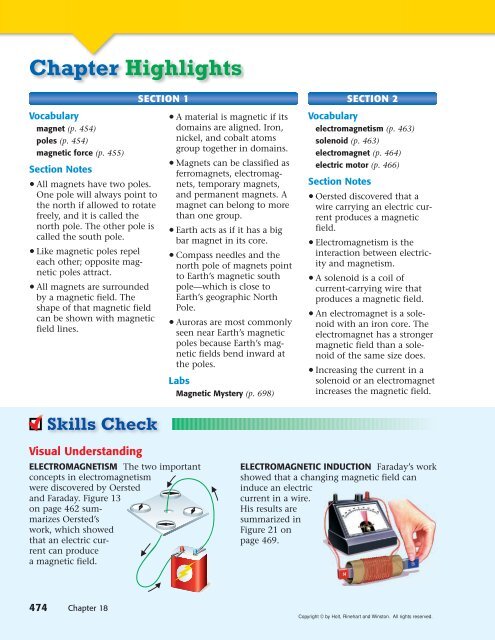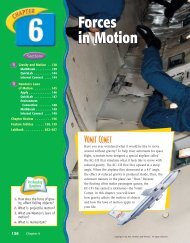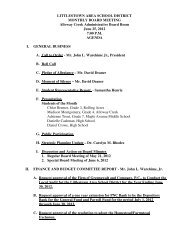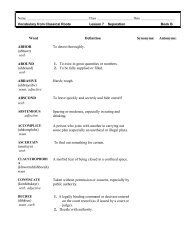Electromagnetism Electromagnetism
Electromagnetism Electromagnetism
Electromagnetism Electromagnetism
You also want an ePaper? Increase the reach of your titles
YUMPU automatically turns print PDFs into web optimized ePapers that Google loves.
Chapter Highlights<br />
Vocabulary<br />
magnet (p. 454)<br />
poles (p. 454)<br />
magnetic force (p. 455)<br />
Section Notes<br />
• All magnets have two poles.<br />
One pole will always point to<br />
the north if allowed to rotate<br />
freely, and it is called the<br />
north pole. The other pole is<br />
called the south pole.<br />
• Like magnetic poles repel<br />
each other; opposite magnetic<br />
poles attract.<br />
• All magnets are surrounded<br />
by a magnetic field. The<br />
shape of that magnetic field<br />
can be shown with magnetic<br />
field lines.<br />
Visual Understanding<br />
ELECTROMAGNETISM The two important<br />
concepts in electromagnetism<br />
were discovered by Oersted<br />
and Faraday. Figure 13<br />
on page 462 summarizes<br />
Oersted’s<br />
work, which showed<br />
that an electric current<br />
can produce<br />
a magnetic field.<br />
474<br />
Skills Check<br />
Chapter 18<br />
SECTION 1 SECTION 2<br />
• A material is magnetic if its<br />
domains are aligned. Iron,<br />
nickel, and cobalt atoms<br />
group together in domains.<br />
• Magnets can be classified as<br />
ferromagnets, electromagnets,<br />
temporary magnets,<br />
and permanent magnets. A<br />
magnet can belong to more<br />
than one group.<br />
• Earth acts as if it has a big<br />
bar magnet in its core.<br />
• Compass needles and the<br />
north pole of magnets point<br />
to Earth’s magnetic south<br />
pole—which is close to<br />
Earth’s geographic North<br />
Pole.<br />
• Auroras are most commonly<br />
seen near Earth’s magnetic<br />
poles because Earth’s magnetic<br />
fields bend inward at<br />
the poles.<br />
Labs<br />
Magnetic Mystery (p. 698)<br />
Vocabulary<br />
electromagnetism (p. 463)<br />
solenoid (p. 463)<br />
electromagnet (p. 464)<br />
electric motor (p. 466)<br />
Section Notes<br />
• Oersted discovered that a<br />
wire carrying an electric current<br />
produces a magnetic<br />
field.<br />
• <strong>Electromagnetism</strong> is the<br />
interaction between electricity<br />
and magnetism.<br />
• A solenoid is a coil of<br />
current-carrying wire that<br />
produces a magnetic field.<br />
• An electromagnet is a solenoid<br />
with an iron core. The<br />
electromagnet has a stronger<br />
magnetic field than a solenoid<br />
of the same size does.<br />
• Increasing the current in a<br />
solenoid or an electromagnet<br />
increases the magnetic field.<br />
ELECTROMAGNETIC INDUCTION Faraday’s work<br />
showed that a changing magnetic field can<br />
induce an electric<br />
current in a wire.<br />
His results are<br />
summarized in<br />
Figure 21 on<br />
page 469.<br />
Copyright © by Holt, Rinehart and Winston. All rights reserved.





